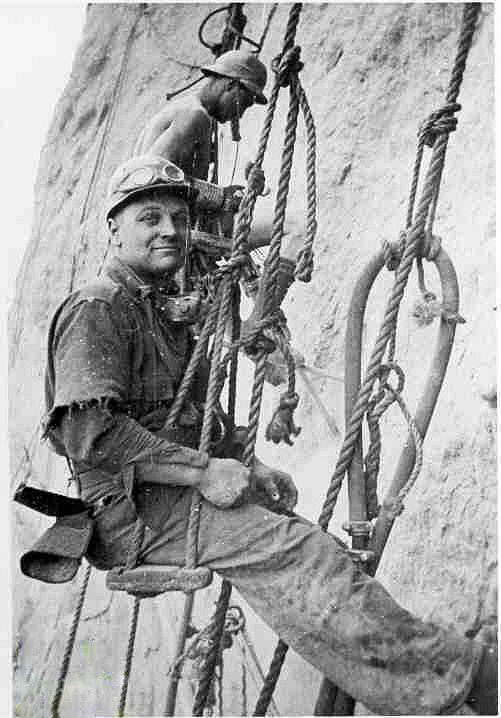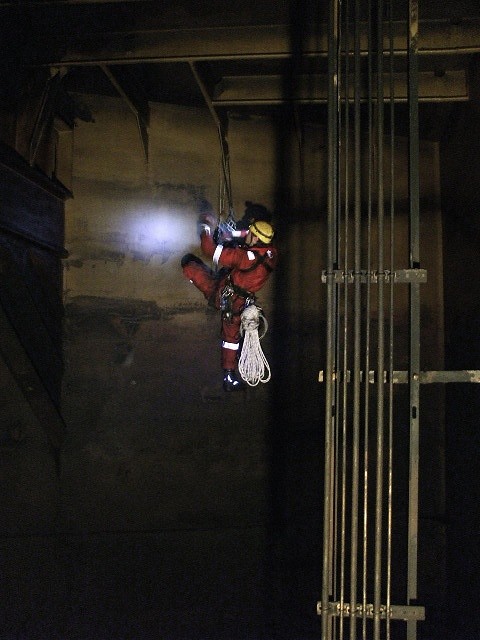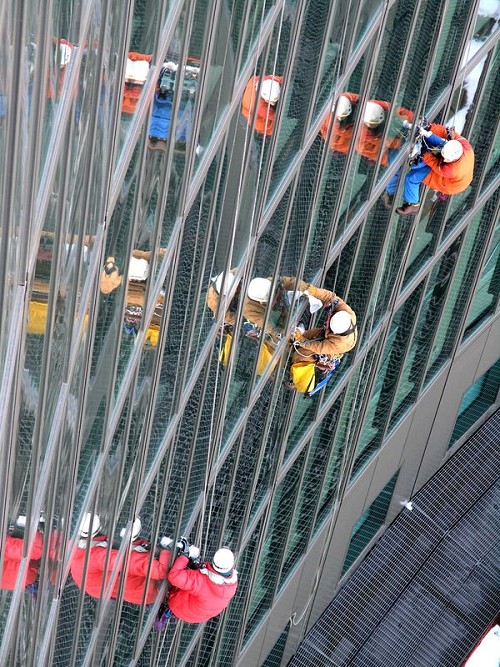
Over the years I've been asked many times about work as a Rope Access technician, often by Instructors and Guides working for themselves in an industry difficult to make a year round living from. How do you get started? Is there plenty of work? And such like. Unsurprising perhaps that it should appeal to climbers who perceive an opportunity to transfer their skills and earn good money.
So, in light of that here's a rundown of the industry and what it's like to live in it.
Early Days
For as long as there have been buildings and structures people having been working at height, using various means to get themselves there. The ancient Greeks and Egyptians used hawser laid ropes made of water reed fibres to suspend workers at height; what would appear to be a steeplejack is depicted on the Bayeux Tapestry.
One of the earlier forms of access by rope involved a team of men lowering another brave/unfortunate, hand over hand, down the workface on what (still is) known as a Bosuns’ Chair which consists of a plank of wood used as a seat at the end of a rope. This method was used on a grand scale during the building of the Hoover Dam in the 1930s by men who were known as High Scalers whose job it was to clear the canyon walls of loose rock. Some 93 of them lost their lives during the project and today there is a monument to their endeavour in Boulder City, Nevada.

Rope Access in its present form started to materialise in the 1970’s, particulary in France where mountain guides were hired to stabilise cliffs above roads and railways. By the early 1980’s a number of companies in the UK had formed to carry out abseil work on bridges, buildings and transport cuttings. The industry then quickly moved offshore to solve difficult access problems on oil and gas rigs. In 1987 six companies got together and created the Industrial Rope Access Trade Association (IRATA) in order to promote the business and control standards. Nowadays they are pretty much the governing body of rope access internationally, and although some other countries have similar smaller organisations, IRATA is the foremost recognised worldwide.
The Work
Jobs can sometimes be very dull and involve no more than routine tasks not far from the ground. Consequently an ability to deal with monotony as well as long shifts and lengthy periods away from home is advantageous.
On the other hand it can be exhilirating and involving; climbing around on famous bridges, skyscrapers and oil rigs in far flung places. Travel can feature quite a lot, occasionally to amazing exotic places, and then again sometimes to the least enjoyable places on the planet!
|
The tasks that people do vary enormously, for example: Historic building restoration |
Becoming Qualified

The IRATA system consists of three progressive levels of certification. Level 1 being entry, Level 2 a working, experienced technician and Level 3 a supervisor responsible for all rope access activies and often the job as a whole. Many technicians with strong trades backgrounds remain at Level 1 or 2, with no imperative to progress to Level 3.
It costs around £700 odd plus VAT to attend an IRATA Level 1 course, which usually consists of four days of training and one of assessment. These have to be revalidated or upgraded every three years.
During the training candidates learn about health and safety, the personal protective equipment (PPE) used, a range of aerial manoeuvers and for Level 1, a simple rescue. These will include ascending and descending ropes, transfers, deviations, re-belays and aid climbing. All good fun, and for anyone who has previously put a harness on and done some climbing, not too stressfull. On the other hand the prospective Level 3 will be pushed to the limit of their ability and be required to pull off all manner of involved rescues, often with an added complication factor.
Getting a Job
A good number of years ago it was predominantly climbers and cavers doing the work but this has changed gradually and now I come across few climbers and even fewer cavers. The vast majority are trades people who have become certified in order to diversify their work, and sometimes as a requirement of their job.
Having a plan and then being prepared to abandon it in favour of just plain doggedness, in the event that things aren’t working out as hoped is essential. Many times I’ve known people become dissenchanted and ultimately give up after spending a fortune on courses. A good way to scope out what companies are looking for is to scan the Rope Access Jobs section here.
Most of these disciplines, especially in the energy industry, require trade certifications which vary from courses lasting a couple of days to a full apprenticeship. Prospective entranants to the industry should ask themselves ‘what can I offer”, given that a Rope Access certificate is not enough in itself.
Girls?
Ladies are under-represented in the industry, but there’s no good reason for it. Even in the supposed strongholds of unreconstructed males offshore, life is surprisingly civilised and poor behaviour is simply not tolerated. Having said that there does still seem to be an invisible hurdle that makers it harder for women to compete with their male counterparts to get a job. Once established there should be no problem with acquiring work, regardless of gender.
Money
Rates of pay vary substantially with the energy industry usually being the highest paying. Hourly rates may be anything from £12 - £40. For a new technician, working onshore, this may be considerably less. Given time and experience, however, very high salaries are possible.
Is it worth it?
For those looking for a quick easy way to make money - probably not. Guiding and rope access can be awkward partners, until well established. Mountain Instructor level work has become quite competitive nowadays, with high numbers buying into a lifestyle where if you dissappear for a while it can be hard to re-establish. And on the other hand, many rope access companies are now big multinationals seeking regular employees. In the past I’ve been looked at as if mad when turning down a steady, permanent slot offshore in favour of living in the dust somewhere for weeks on end!
Each to their own...
For those prepared to commit time and money, why not? It’s a long term investment in a growing industry and can return two very valuable commodities: money and time, which for a keen climber is gold dust, an expedition every year!















Comments